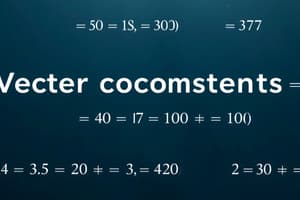Podcast
Questions and Answers
What does resolving a vector into components mean?
What does resolving a vector into components mean?
- Breaking down a single vector into multiple vectors (correct)
- Reconstructing the original vector
- Dividing a vector into horizontal and vertical components
- Combining multiple vectors to form a new vector
Which term is used to describe the constituent vectors of the original vector?
Which term is used to describe the constituent vectors of the original vector?
- Orthogonal vectors
- Trigonometric vectors
- Decomposed vectors
- Component vectors (correct)
What is the process of breaking down a vector into its components called?
What is the process of breaking down a vector into its components called?
- Vector disintegration
- Vector harmonization
- Vector combination
- Vector resolution (correct)
Why is it useful to resolve a vector into orthogonal components?
Why is it useful to resolve a vector into orthogonal components?
Which pair of components are typically used in resolving a vector in two-dimensional space?
Which pair of components are typically used in resolving a vector in two-dimensional space?
What does leveraging the right-angled triangle formed by components allow in vector analysis?
What does leveraging the right-angled triangle formed by components allow in vector analysis?
Which concept facilitates a straightforward approach to problem-solving in physics?
Which concept facilitates a straightforward approach to problem-solving in physics?
In which situation would breaking down a vector into components not be helpful?
In which situation would breaking down a vector into components not be helpful?
How is the horizontal component of a vector found using trigonometric identities?
How is the horizontal component of a vector found using trigonometric identities?
What trigonometric ratio is utilized to find the vertical component of a vector?
What trigonometric ratio is utilized to find the vertical component of a vector?
In resolving vectors into components, what do the horizontal and vertical components enable?
In resolving vectors into components, what do the horizontal and vertical components enable?
What is the horizontal component when a force of 180 N acts at an angle of 45° to the positive x-axis?
What is the horizontal component when a force of 180 N acts at an angle of 45° to the positive x-axis?
When adding vectors using components, what is the first step in determining the resultant vector?
When adding vectors using components, what is the first step in determining the resultant vector?
What is a key advantage of resolving vectors into components when determining resultants?
What is a key advantage of resolving vectors into components when determining resultants?
In a graphical vector analysis, what is determined by summing all vertical (y) components of vectors?
In a graphical vector analysis, what is determined by summing all vertical (y) components of vectors?
When applying trigonometric identities to resolve vectors, what does $\vec{R}_y = R \sin(\theta)$ represent?
When applying trigonometric identities to resolve vectors, what does $\vec{R}_y = R \sin(\theta)$ represent?
What is the vertical component when a force of 20 N acts at an angle of 60° to the positive x-axis?
What is the vertical component when a force of 20 N acts at an angle of 60° to the positive x-axis?
How is the horizontal component of a vector determined using trigonometric identities?
How is the horizontal component of a vector determined using trigonometric identities?
In resolving vectors into components, what does the vertical component represent?
In resolving vectors into components, what does the vertical component represent?
When resolving a vector into components for vector addition, why is it necessary to sum all horizontal (x) components?
When resolving a vector into components for vector addition, why is it necessary to sum all horizontal (x) components?
What role does the Pythagorean theorem play in adding vectors using components?
What role does the Pythagorean theorem play in adding vectors using components?
In vector analysis, what does summing all vertical (y) components help in determining?
In vector analysis, what does summing all vertical (y) components help in determining?
How is the vertical component of a vector determined using trigonometric identities?
How is the vertical component of a vector determined using trigonometric identities?
What is the role of the Pythagorean theorem in adding vectors using components?
What is the role of the Pythagorean theorem in adding vectors using components?
When resolving vectors into components, what does $R_x = R imes ext{cos}( heta)$ represent?
When resolving vectors into components, what does $R_x = R imes ext{cos}( heta)$ represent?
What facilitates a straightforward approach to problem-solving in physics when analyzing vectors?
What facilitates a straightforward approach to problem-solving in physics when analyzing vectors?
In vector analysis, what is determined by summing all vertical (y) components of vectors?
In vector analysis, what is determined by summing all vertical (y) components of vectors?
Why is it beneficial to sketch vectors and their components when adding vectors using components?
Why is it beneficial to sketch vectors and their components when adding vectors using components?
What happens when each vector in a system is decomposed into its x- and y-components for vector addition?
What happens when each vector in a system is decomposed into its x- and y-components for vector addition?
When resolving a vector into components, what does $ heta$ represent?
When resolving a vector into components, what does $ heta$ represent?
When a vector is broken down into multiple vectors, what are these constituent vectors known as?
When a vector is broken down into multiple vectors, what are these constituent vectors known as?
In the context of resolving vectors into components, what does orthogonal mean?
In the context of resolving vectors into components, what does orthogonal mean?
If a vector has horizontal and vertical components denoted by $\vec{A}_x$ and $\vec{A}_y$ respectively, how are these components related geometrically?
If a vector has horizontal and vertical components denoted by $\vec{A}_x$ and $\vec{A}_y$ respectively, how are these components related geometrically?
What is the result of resolving a vector into its horizontal and vertical components?
What is the result of resolving a vector into its horizontal and vertical components?
In vector analysis, why are orthogonal components particularly useful?
In vector analysis, why are orthogonal components particularly useful?
If a vector is resolved into components that are not orthogonal, what impact does this have on problem-solving?
If a vector is resolved into components that are not orthogonal, what impact does this have on problem-solving?
When a vector is broken down into its components, which method is employed to determine the magnitudes of these components?
When a vector is broken down into its components, which method is employed to determine the magnitudes of these components?
What geometric shape is leveraged when breaking down a vector into its horizontal and vertical components?
What geometric shape is leveraged when breaking down a vector into its horizontal and vertical components?
If a vector is resolved into non-orthogonal components, what method becomes challenging to apply for analysis?
If a vector is resolved into non-orthogonal components, what method becomes challenging to apply for analysis?
In two-dimensional space, how would resolving a vector into orthogonal components aid in problem-solving?
In two-dimensional space, how would resolving a vector into orthogonal components aid in problem-solving?
What is the mathematical method for determining the horizontal component of a vector?
What is the mathematical method for determining the horizontal component of a vector?
When a vector is resolved into components, what does the vertical component physically represent?
When a vector is resolved into components, what does the vertical component physically represent?
In vector addition using components, what does summing all horizontal (x) components help in determining?
In vector addition using components, what does summing all horizontal (x) components help in determining?
What is the key role of trigonometric ratios when resolving vectors into components?
What is the key role of trigonometric ratios when resolving vectors into components?
When decomposing vectors into their components, what issue arises if one component is missing?
When decomposing vectors into their components, what issue arises if one component is missing?
How does breaking down a vector into its components simplify vector analysis?
How does breaking down a vector into its components simplify vector analysis?
Why is it essential to sum all vertical (y) components when adding vectors using components?
Why is it essential to sum all vertical (y) components when adding vectors using components?
What is a common misconception students might have about vector resolution into components?
What is a common misconception students might have about vector resolution into components?
When resolving a vector into components, what could be a likely issue if incorrect trigonometric identities are applied?
When resolving a vector into components, what could be a likely issue if incorrect trigonometric identities are applied?
What concept emphasizes the importance of decomposing vectors for efficient analytical processes?
What concept emphasizes the importance of decomposing vectors for efficient analytical processes?
What is the primary purpose of resolving a vector into components in physics?
What is the primary purpose of resolving a vector into components in physics?
When a vector is resolved into horizontal and vertical components, what does the horizontal component represent geometrically?
When a vector is resolved into horizontal and vertical components, what does the horizontal component represent geometrically?
What term is used to describe the process of breaking down a vector into its components?
What term is used to describe the process of breaking down a vector into its components?
In two-dimensional space, if a vector is resolved into its horizontal and vertical components, what geometric shape does the right-angled triangle formed by these components represent?
In two-dimensional space, if a vector is resolved into its horizontal and vertical components, what geometric shape does the right-angled triangle formed by these components represent?
When resolving a vector into components, what trigonometric identities are typically applied to ascertain the magnitudes of the components?
When resolving a vector into components, what trigonometric identities are typically applied to ascertain the magnitudes of the components?
In physics, why is it necessary for vectors to be resolved into orthogonal components?
In physics, why is it necessary for vectors to be resolved into orthogonal components?
What critical advantage is gained by resolving a vector into horizontal and vertical components for two-dimensional analysis?
What critical advantage is gained by resolving a vector into horizontal and vertical components for two-dimensional analysis?
When breaking down a vector into components, what does the term 'orthogonal' refer to?
When breaking down a vector into components, what does the term 'orthogonal' refer to?
What concept allows for a more direct approach to analyzing vectors by breaking them down into horizontal and vertical components?
What concept allows for a more direct approach to analyzing vectors by breaking them down into horizontal and vertical components?
When resolving vectors into its horizontal and vertical components, what essential mathematical tool is utilized for determining their magnitudes?
When resolving vectors into its horizontal and vertical components, what essential mathematical tool is utilized for determining their magnitudes?




